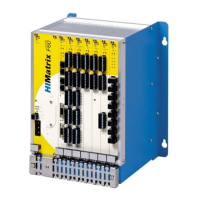System Manual Modular Systems 7 Start-Up
HI 800 191 E Rev. 2.02 Page 93 of 114
3. Receive TMO
ReceiveTMO is the monitoring time of PES1 within which a correct response from PES2
must be received.
Figure 16: Setting the Parameters in the P2P Editor - up to CPU OS V7
The parameters specified above determine the data throughput and the fault and collision
tolerance of the safeethernet connection.
Refer to the HIMatrix Safety manual (HI 800 023 E), Chapter Configuring Communication, for
details on how to calculate the ReceiveTMO, Response Time and Worst Case Reaction Time.
Profile
Due to the high number of parameters, the manual network configuration is very complex and
requires a thorough knowledge of the parameters and their mutual influence.
To simplify the parameter settings, six peer-to-peer profiles are available, among which the user
can select the most suitable for his application and network.
The profiles are combinations of parameters compatible with one another that are automatically
set when selecting the profile.
Profiles I through VI are described in details in the ELOP II Factory Hardware Management
online help.
7.8.4 Configuring the Signals for safeethernet Communication
A network (token group) must have been created beforehand, to be able to configure signals,
see ELOP II Factory manual First Steps (HI 800 006 E).
To configure the signals for safeethernet communication
1. In the P2P Editor, click a line number in the left-hand column to select the resource with
which data should be exchanged.
2. In the P2P Editor, click Connect Process Signals.
When the Process Signals opens for the first time, it is empty.
3. In the Signals menu, select Editor to open the Signal Editor.
4. Arrange the Signal Editor and P2P Process Signals windows adjacent to one another.
5. In the P2P Process Signals window, select the tab corresponding to the desired data transfer
direction, e.g., from the resource selected in the structure tree to the resource selected in the
P2P Editor.
6. Drag a signal name from the Signal Editor onto the desired row in the P2P Process Signals
window.
As an option, use the Add Signal button. A row is created where the name of the signal can
be entered; the signal name is case sensitive.

